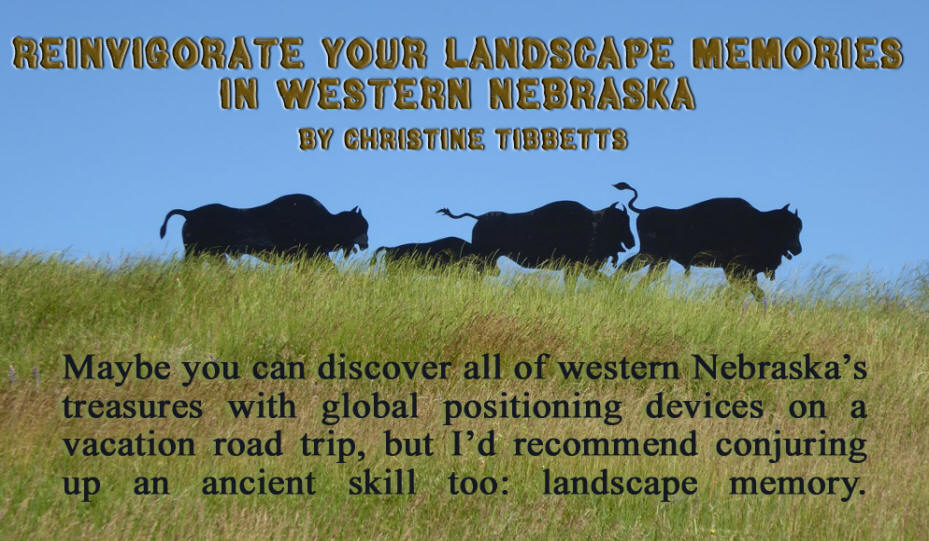
The vast
views in this part of America's west should be absorbed with
long gazes, the deep breathing kind, staring at startling
beauty. Plenty of modern homesteaders in the know can tell you
how ancient civilizations and wagon train pioneers found their
way.
 |
Illusions of bison at the Hudson-Meng Educational Center
on Pine Ridge
in Chadron, Nebraska where the bones
are very real.
|
"You are in some of the most scenic land in North America," says
Dennis Kuhnel, walking in grasslands just beyond the remains of
600 bison killed by Paleo Indians maybe 10,000 years ago.
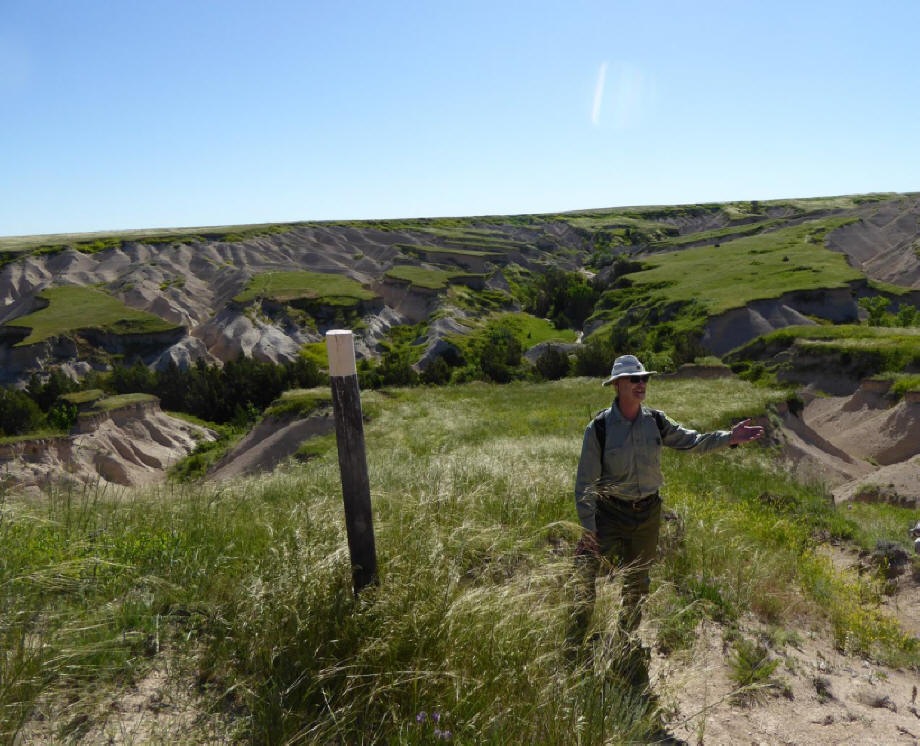 |
|
Walk through time from 13,000
years to 24 million on a three-mile trek from
Hudson-Meng Educational Center.with archeologist Dennis
Frye
|
"They found their way with landscape
memories, remembering landmarks," Kuhnel says of "the first
people some 13,000 years ago in these grasslands created during
the last glacial millennia."
Here's how you can walk where they trod:
visit the Hudson-Meng Educational Center on Pine Ridge in
Chadron. Kuhnel's the director of this archeological site and
knows the way through three different ecological eras.
This is a walk
through time, starting 13,000 years ago and ending three miles
later in an ancient riverbed 38 to 24 million years old.
Toadstool Geologic Park is the name and if a hike doesn't suit
you, drive from the education center about eight miles to the
edge of this park to experience whimsical but enormous clay
pillars with sandstone slabs on top.
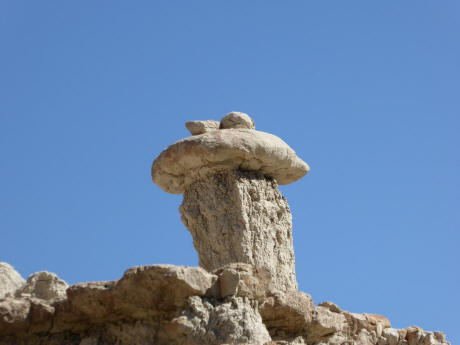 |
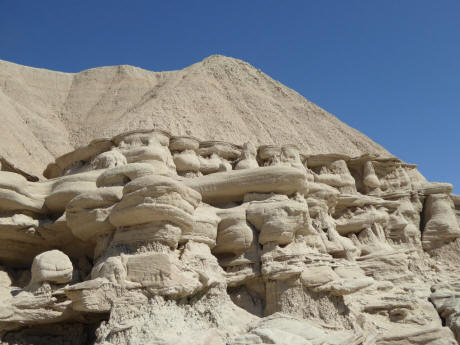 |
|
Routine views walking in Toadstool Geological Park. |
Fossils of animals walking this ancient
streambed are visible, as are ancient tracks of giant pigs, two
species of rhino, miniature horses and ancestors of modern
camels, dogs and cats.
Eons of time
Walking
through eons of time is but one of western Nebraska's wonders.
Tracking national monuments,
trails, wilderness areas and scenic rivers is another.
Maybe some other road-trip friendly
place in America has as many national designations within reach
on a family vacation, but I'm doubtful.
Plenty of people intend to visit every
National Park. After exploring Scottsbluff and Ogallala, Sidney
and the Sandhills, Alliance and wide-open roadways I'm
recognizing a different plan---steep my soul in natural wonders
considered national treasures.
Says who? One
resource would be the families in wagon trains heading west to
seek a new life. Their diaries can guide many western Nebraska
discoveries.
Pioneer diaries
Like Chimney Rock which historian Loren
Pospisil says is mentioned more times in the diaries of Oregon
Trail travelers than any other landmark.
 |
|
Big
Nebraska views from the top of Scotts Bluff National
Monument, walking down. |
Yes it is startling in its spiral
formation reaching high out of the open plains but those
pioneers moving only three miles an hour would have looked
toward it much longer than you approaching in a car.
Pony Express riders liked this landmark
too because of the clear water stream nearby. You can see a
handsome monument honoring these deliverers of the mail in 1860
and 1861 in Sidney, where the outdoors outfitter Cabela's
maintains its world headquarters.
Hear wild west stories too; in fact,
Sidney is the subject of "Lynchings, Legends, Lawlessness," 680
pages of history to make you wonder why you didn't know about
this Nebraska town sooner.
Sidney has a
Boot Hill (and so does Ogallala) where cowboys were buried with
their boots on, and says City Manager Gary Person, sometimes
with barbed wire around their necks.
It was also a gateway to the gold rush
in the Black Hills of Dakota, and today the rest of us can drive
on U.S. 385, also designated the Gold Rush Byway.
Views never end
Driving is important in western
Nebraska, and so is keeping the tank on the full side of half.
The views never end, but towns with facilities can be far from
one another.
Before you go,
order this map: "Journey to Western Nebraska: Weekends Out
West."
It's clear, straightforward
and sensible.
Here's how: 800-684-4066 or
www.westnebraska.com
See if the National Park Service will
send you their stellar maps of the trails you can experience:
Oregon, California, Mormon Pioneer and Pony Express. Boundless
ideas to consider mapping your course.
Choose Alliance, due north of Sidney on
the Gold Rush Byway, for a professional, well-funded, museum
break because the Knight Museum and Sandhills Center features
exquisite exhibits.
Could be tough to leave the vast views
for some inside time but you'll be glad to meet the descendent
of homesteaders—Becci Thomas who directs this modern, detailed
museum.
She knows the history in an up close and
personal family way so ask to meet her for a chat. Her
great-grandmother came here as a widow with four children and
Thomas shares stories behind the stories of museum displays.
Meant more to
me seeing a Conestoga wagon from Illinois when I learned the
family name, finding the fourth generation living in Alliance.
Connecting history
Connections enriching history happen all
around this region. Moments like looking at the Platte River and
hearing from a cowboy on his horse that the Oregon Trail
pioneers traipsed on one side and the Mormons on the other.
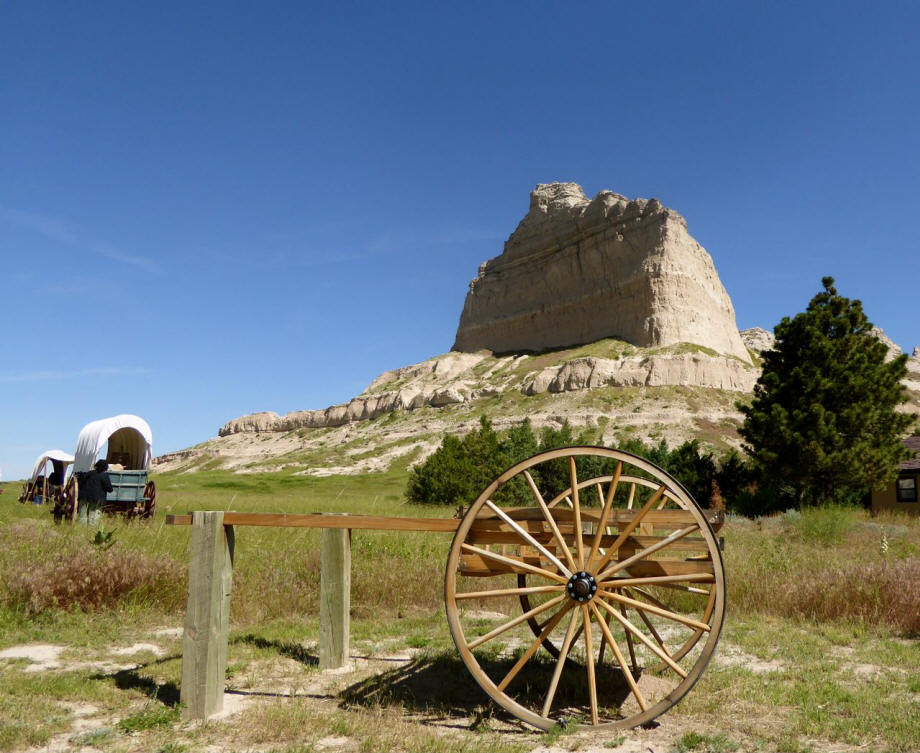 |
Many
pioneers on the Mormon Trail moved their possessions in
handcarts
like this one in front of the Scotts Bluff
National Memorial. |
Then learn on another day of grand views
at Scotts Bluff National Monument that those Oregon Trail
families generally had their goods in a wagon, walking beside
it, and the Mormons had handcarts for their goods.
See one of each side-by-side in front of
this landmark pinpointing nearby Mitchell Pass, a gap allowing
passage through the towering bluffs.
 |
|
Mitchell Pass
was a welcome site to Oregon Trail travelers, seeing a
way through the giant bluffs. |
For more on western Nebraska
click here
Keep these national designations in
mind
designing a trip
No simple task narrowing down the choices!
National Monuments
Scotts Bluff
Agate Fossil Beds
National Wilderness
Soldier's Creek near Fort Robinson State
Park,
itself a fine place to book many nights
National Scenic River
The Niobrara with six ecological systems
National Natural Landmark
Sandhills (Mongolia is the only other
place to find these)
8,000 years old with 85% of the natural
habitat never plowed
National Historic Trails
Oregon
California
Pony Express
Mormon Pioneer
Lincoln Highway (first auto road across
the entire USA)
Transatlantic Railroad
National Historic Site
Chimney Rock with visitor center, film
and museum
Reading before
you travel to bring new richness to discovery, then rereading
later adding to the literature a traveler's personal
experiences.
Allan Maybee
of Barn Anew suggested these two last night when I interviewed
him on Blog Talk Radio (Travel Itch Radio show)
Centennial James Michener
Oregon
Trail Revisited Greg Franzwa
Of course, we know Lonesome Dove
James McMurtry
Our guide at Fort Robinson said --
Killing of Crazy Horse by
Tom Powers
and
Crazy Horse: A Lakota Life
by Kingsley Bray
|